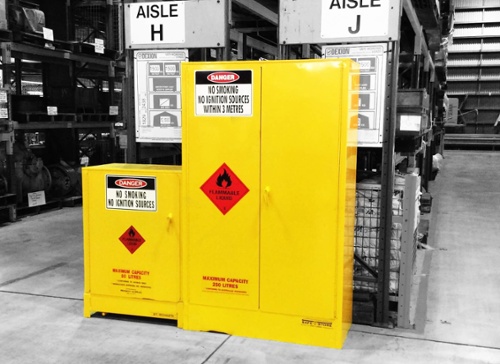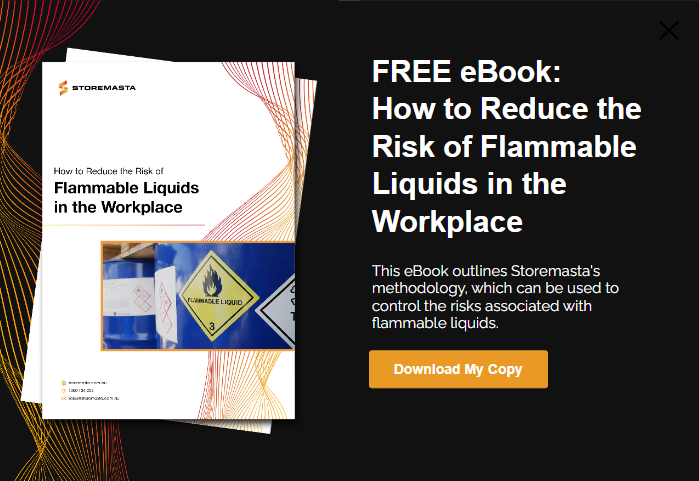Of the 9 classes of dangerous goods, Class 3 Flammable Liquids are used the most frequently due to their ability to readily combust and release energy. This energy can be used to power engines in power stations, automobiles, earth movers, generators and many other machines. Flammable liquids are also the vital ingredients in many cleaning agents, thinners, solvents, adhesives, polishes, waxes, paints and varnishes.
While flammable liquids are extremely useful in our modern society, their dangerous chemical and physical properties pose risks upon people, property and the environment. Flammable liquids will emit flammable vapours at temperatures below 60 °C. If these flammable vapours come into contact with an ignition source, they will ignite and cause a fast-burning fire. Large quantities of flammable vapours in the workplace can also cause human harm, including asphyxiation.
To mitigate the risks associated with flammable liquids, they must be stored in a safe and compliant manner. This can be achieved by keeping all flammable liquids in a compliant flammable storage cabinet.
Features of a Flammable Storage Cabinet
To ensure safety and compliance onsite, flammable cabinets must feature a range of controls to reduce the hazards associated with Class 3 Flammable Liquids. This includes fire risk, incompatabilities with other dangerous goods, leaks, spills and the release of flammable vapours that may ignite.
We'll now explain how the features of a flammable storage cabinet achieve these four critical functions.
Flammable liquids storage cabinets are specifically designed and constructed to reduce the many risks associated with Class 3 chemicals.
Protect Contents Within the Cabinet Against Damage
When flammable liquids are used in the workplace, it is important to ensure that their packaging doesn’t get damaged and the contents within the packages aren’t contaminated. If packages of flammable liquids are damaged, it can cause the flammable liquids to leak out into the workplace. Uncontained flammable liquids disperse flammable vapours more readily. If these flammable vapours come into contact with an ignition source, they will ignite and cause a severe fire that would harm people and property. A flammable liquids storage cabinet that has been manufactured in full conformance to AS 1940 will have a dual skinned sheet steel construction. This heavy duty construction will protect the contents within the cabinet from being damaged by external moving objects.
If contaminated flammable liquids were used in a machine or manufacturing processes, the machine or the end product of the manufacturing process would become damaged. This damage could cost the business a lot of money as the result of downtime and loss of machinery. This risk can be mitigated by storing flammable liquids in a compliant flammable liquids storage cabinet.
Flammable storage cabinets are therefore also constructed with self-closing, close-fitting doors that keep out any contaminants that could potentially mix with the flammable liquids.
Provide Segregation between Incompatible Chemicals
Like most classes of dangerous goods, Class 3 Flammable Liquids are incompatible with many other classes.
Some dangerous goods classes that are incompatible with flammable liquids include:
- Division 5.1 - Oxidising agents
- Division 5.2 - Organic peroxides
- Division 6.1 - Toxic substances
- Class 8 - Corrosive substances
Incompatible substances are substances that are likely to increase risk to people, property and the environment when mixed.
Access your FREE chemical segregation chart
If incompatible substances mix, it could result in a violent chemical reaction. Violent chemical reactions can produce explosions and the rapid evolution of heat and pungent toxic gases.
To avoid the risk of violent chemical reactions, incompatible substances must be safely segregated. This can be achieved by separating incompatible substances by certain distances or storing incompatible chemicals in separate safety cabinets.
Flammable storage cabinets are extremely useful for segregating flammable liquids from other classes of dangerous goods in confined spaces. Please note that the segregation guidelines for incompatible substances still does apply.
Provide Spill Containment
Flammable liquids spills are another risk associated with the storage of flammable liquids in the workplace.
A flammable liquids leak or spill can have many negative implications in the workplace. Some key hazards associated with the accidental release of flammable liquids include:
- Staff, contractors or site visitors slipping and falling on spilled liquids
- Workplace fires or explosions due to the release of flammable vapours
- Asphyxiation occurring when flammable liquid are spilled and vapours are breathed in by staff
- Environmental pollution can occur when liquids pass into soil or waterways
Therefore, choosing to store your Class 3 Flammable Liquids in a compliant flammable storage cabinet is an effective and essential hazard control measure that will reduce the likelihood and impact of accidental chemical releases.
AS 1940, which is the standard that outlines the requirements for the storage and handling of flammable liquids, states the flammable liquids storage cabinets must have a liquid-tight spill containment sump in the bottom of the cabinet that is at least 150mm deep. This spill containment sump catches any flammable liquids leaks or spills that may occur within the cabinet — and stops them from entering the workplace.
Fire Protection
If a fire occurred in a workplace that carried flammable liquids, the chemicals would instantly ignite and intensify the rate of fire spread. This kind of incident would decrease the chance of workers escaping the fire.
To prevent flammable liquids from instantly igniting in the event of a workplace fire, flammable liquids must be stored in flammable storage cabinets that comply with AS 1940.
Safety cabinets that are purpose-built for Class 3 Flammable Liquids are specifically designed to create a fire buffer.
This feature works in two ways:
- The cabinet is liquid tight with close-fitting doors. This keeps flammable vapours fully contained in the cabinet, and they are isolated from ignition sources.
- The construction materials and componentry of the cabinets can withstand heat of up to 850°C.
REMEMBER: The fire buffer will only work if the cabinet is used corrected — ie, installed on a level surface, only flammable liquids stored inside, loaded within the approved capacity rating, the doors are kept closed, and nothing placed in the lower spill compound.
Why Do I Need a Flammable Storage Cabinet?
Overall, the use of flammable liquids storage cabinets decreases the risk that flammable liquids pose upon the people, property and environment of your organisation. Using flammable liquids storage cabinets is a great start to reducing workplace risk. The ultimate solution is to implement a methodology for managing the risk that incorporates each facet of the hierarchy of controls. If you would like more information on how to reduce the risk associated with flammable liquids, download our FREE ebook by clicking on the image below.Joining the team as a Dangerous Goods Storage Consultant, Melissa Hampton became Storemasta's Marketing Manager in late 2021. With extensive knowledge and experience in chemical compliance, Melissa is responsible for leading the Marketing team and helping shape their marketing strategy. In her spare time, you can find Melissa hiking, swimming and enjoying the great outdoors in beautiful north-west Tasmania.


